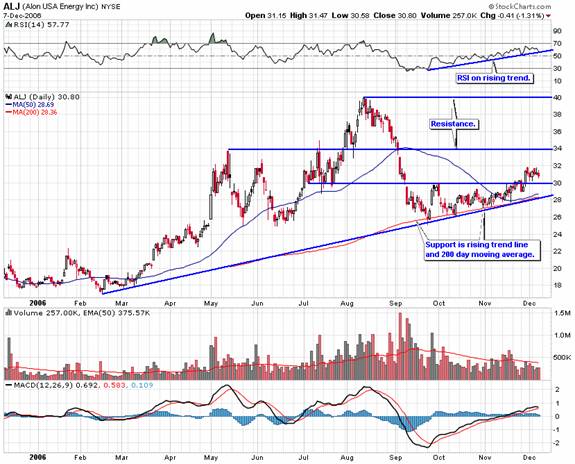How to Set Stop Losses to Lock in Profits
InvestorEducation / Investing Feb 16, 2007 - 07:17 AM GMTBy: Hans_Wagner
 I have had several questions regarding how I set stops and why sometimes I use a trailing percent stop and other times I use a specific price. I hope to help clarify my approach with this Point of Interest. The trailing stop is an excellent method to lock in profits or protect from greater losses. By placing a stop order below the current price it limits your loss to a predetermined amount. When the bid price hits the stop price your position is sold and you exit your position.
I have had several questions regarding how I set stops and why sometimes I use a trailing percent stop and other times I use a specific price. I hope to help clarify my approach with this Point of Interest. The trailing stop is an excellent method to lock in profits or protect from greater losses. By placing a stop order below the current price it limits your loss to a predetermined amount. When the bid price hits the stop price your position is sold and you exit your position.
The goal of a trailing stop is to let your profits run while protecting most of them in the event of a change in the stock's trend. The trailing stop should be far enough away from the current price level to compensate for normal volatility as price moves in a larger trend. While this article is based on long positions, the same concepts hold for short positions as well.
There are three primary ways to set a trailing stop, two of which reset automatically. The three trailing stop methods are:
-
A percentage below the current price;
-
A fixed number of points below the current price and;
-
A specific stop price based on a technical indicator or support level that you adjust as the price of your stock raises.
Trailing Percent
The trailing percent stop trails price movements by a set percentage, but only in the direction of the trend. If the price reverses direction, the stop remains at its previous level and will be activated if the price falls below the trailing percentage. The trigger price is readjusted each time a new high is reached. If the stock's price begins to fall and reaches your calculated stop price, your order will be triggered as a market order and your stock will be sold for the best available price.
Setting the percent for the trailing stop depends on your personal risk capacity, the trend in the market and the volatility of the stock. For me I do not wish to take on a lot of risk, which is why I like to buy quality companies at a discounted price. As a result I believe I can have a lower trailing percent than many other people use. When the market is trending strongly up, a trailing percent can be slightly larger than when the market is flat or in a secular bear market. It gives the stock more room to move on its way up. Finally, the volatility of the stock helps to establish the percent. The article Setting Trailing Stops discusses a way to calculate the trailing percent based on the latest month's volatility.
Trailing Points
Another way to set your trailing stop is to use trailing points. This method is very similar to the trailing percent method, only you use a set number of points below the high price, instead of a percentage. If the price reverses direction, the stop remains at its previous level and will be activated if the price falls by more than the trailing points. The trigger price is readjusted each time a new high is reached. If the stock's price begins to fall and reaches your calculated stop price, your order will be triggered as a market order and your stock will be sold for the best available price.
Specific Price
The third way to set a trailing stop is to use a specific price. This technique takes advantage of the market psychology that is imbedded in the price and volume of a stock. Technicians call these levels support and resistance. Support is the level which a stock seems to find more buyers than sellers and as a result usually has difficulty going lower. Support levels are where buying overcomes the selling that is causing the price to fall. Resistance is the level where a stock seems to find more sellers than buyers and usually has difficulty going higher. Often these areas are where the stock price has stopped going down and started going up again. Unfortunately, setting a price just under a support area does not automatically move up on its own. You must monitor the price movement and adjust the stop price on your own.
My Basic Approach
The ideal stop limits down side risk without executing on a pull back within a rising up trend. When setting the initial and then trailing stop I go through a progression as follows:
1. Look for support levels on the chart that includes key moving averages such as the 50 and 200 day. Note how many times the support level has held and the volume action as the price maneuvers near the support level. If there is stronger volume on the move up away from the support level it is a good sign that this is a strong support level.
2. Calculate the trailing percent stop. This gives me another estimate of where to place a potential stop.
3. Select the best stop method to use given the specific situation of the stock in question. This decision is based on your best judgment and experience. If support levels are very close and the percent stop would give the price more room to move, I will select the percent stop. If there is support just below the percent stop then I might select the specific price just below the support level rather than the percent stop. In each case I decide how much I am willing to lose with each approach.
4. Monitor the price performance and review which stop method to use as the price move up. There are times when the percent stop is best and there will be times when the specific price just below a support level will be best. As the price approaches your target, you may want to tighten up your stop to be sure you capture the most profits.
 |
Below is a chart of ALJ. Here is my thinking on setting stops for ALJ. Originally, I used the percentage stop to begin the trade, as I believe it was the best way to begin. It provided sufficient initial room for the price to move, without risking more money. Later as the price rose, I felt the rising trend line and the 200 moving average was a better place to place the stop. I am expecting this trade to last for several months, so I want to leave some room for it to move before getting stopped out. However, if you are a shorter term investor or feel that you would not want to risk the additional downside that a lower stop offers, then I would stick with the 8.7% stop. You might also believe that if the market consolidates and possibly pulls back and take ALJ with it. This would be another reason to stay with the 8.7% stop. You can always buy back in.

Conclusion
So which trailing stop should you use? I am unaware of any study that statistically proves one is better than the other. Successful investors and traders use each method. I like to use both the Percent Volatility and the Specific Price based on support and resistance levels. These two methods have some basis in behavioral psychology of the market. I examine the stop each method identifies and then choose the one that seems to fit the current situation the best. I also use what I know about the overall market trends and cycles, the strength of the trend in place and the general economy to help set my stop.
By Hans Wagner
tradingonlinemarkets.com
My Name is Hans Wagner and as a long time investor, I was fortunate to retire at 55. I believe you can employ simple investment principles to find and evaluate companies before committing one's hard earned money. Recently, after my children and their friends graduated from college, I found my self helping them to learn about the stock market and investing in stocks. As a result I created a website that provides a growing set of information on many investing topics along with sample portfolios that consistently beat the market at http://www.tradingonlinemarkets.com/
© 2005-2022 http://www.MarketOracle.co.uk - The Market Oracle is a FREE Daily Financial Markets Analysis & Forecasting online publication.


